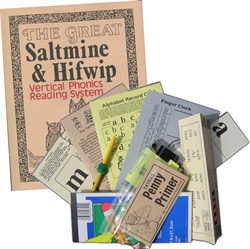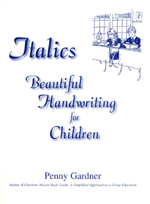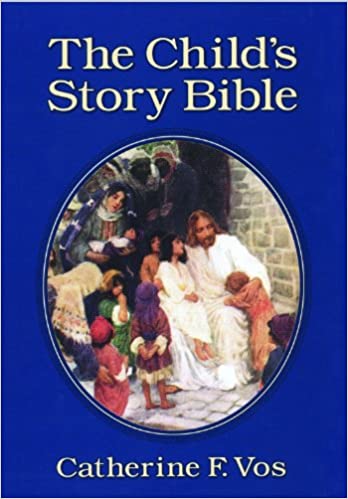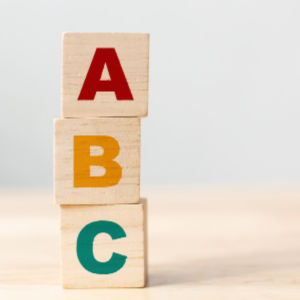
When you’re just beginning to homeschool preschool, kindergarten, and first grade, it can be an overwhelming challenge to decide what, out of all the sparkling and pretty and slick curriculum packages out there, to settle on and use.
I’ve taken 5 children through this stage and I can testify: Children develop at different rates, at different times, and it’s best not to try to hurry them along or rush them through.
Yet it is also our responsibility as parents to watch their readiness and cultivate their interest.
In this article, I’ll share what we’ve done during this stage of our homeschooling and what materials we’ve chosen to classically educate our preschoolers, kindergarteners, and first graders.
Learning Goals for Preschool & Kindergarten
I believe that the best preschool experience for the 5-and-under crowd is simply living alongside their mothers, who talk and correct and hug and love. Plus, of course, as much time outdoors as can be managed.
It is simply false that more table work and more chants and disjointed facts will prepare kindergarteners for rigorous school later. We must do work appropriate to their stage, not rush them on to the next one and skip needed development.
Even for (especially for) classical homeschoolers, a laid-back bookish and outdoorsy childhood lays the groundwork for a well-educated teen. I promise. Now I also have 4 (almost 5) of those, too.
Many moms (including myself) are going to mix in some phonics and numbers time, but I think that is totally discretionary and non-essential until 6 or 7 years old.
1. Teach Obedience
A child’s first lesson is often learning what “no” means and that his parents are an authority to be trusted and obeyed. That begins well before the pre-k age, but every new stage brings more experimentation with the boundaries and definitions.
My favorite book for parenting little ones is Raising Godly Tomatoes, which is also available for free on her website: RaisingGodlyTomatoes.com. Whenever we find ourselves in a bad way (it’s very cyclical, and that’s normal), I return to her tactics and the extent to which I am consistent, they help bring us all back into fellowship and good habits.
And that’s what it’s ultimately about. It’s not about being in control or being authoritarian (although our family’s style leans that way, not everyone’s does and that’s ok). It’s about establishing rightly ordered relationships and the patterns of interaction that will set you up for being able to instruct them when they are older.
2. Teach Attitude Control
We don’t often notice, but all relationships have patterns, habits, of interactions. And we all have a habitual tone we default to unconsciously. I know I’ve heard accidental or unexpected recordings of myself and been startled: “Do I really sound like that?”
Of course mothers are not the only ones with habitual tones and interaction patterns. Our preschoolers are establishing and experimenting with theirs, as well. They need to learn to say please and thank you, to not whine and pitch a fit, to ask for a turn instead of grabbing, and generally get along in polite society (which includes your family).
The best method I’ve found for helping children with this is to have them repeat a situation gone sour with the right responses and requests, making sure the toddlers aren’t turning into little tyrants, demanding and getting their way because it’s easier to let them have it and make the older ones give in to them.
More than letters or numbers, phonics or counting, we need to take the time to develop healthy response patterns with our little ones.
3. Spark Interest
When it comes to “lessons” at this age: Circle Time, letters & phonics, numbers and counting, reading good books aloud, handwriting, and anything else you might include, my philosophy is to be casual about them all.
I believe that the point of including all those is to capitalize on and encourage their desire to learn (i.e. if they ask for books or math or to copy letters, then by all means give them the opportunity!), to cultivate interest (i.e. show them the world is a fascinating place), and to introduce concepts and habits.
In other words, my goal is not to have them reading by the time they are 5 or 6, or to have them complete the Primer math book, or even necessarily to know all their letters or numbers. So far, all of that happened with my oldest two, but it wasn’t the aim.
If it hadn’t happened, and if it doesn’t happen with my three remaining students, it doesn’t mean I’ve failed or we have to do “summer school” or “make up work” or anything of the kind. It simply means we continue on, waiting for the lightbulbs and also learning good work and application habits.
In all of the elementary years, beginning from the beginning, my focus is more on learning how to learn, on learning that there is much to learn, and on learning that to learn is exciting and rewarding. The content that we learn along the way is mostly tangential.
I care more that they have several interests, that they spend time reading, and that they know what to do when they have a question or want to know about something (and that they aren’t too lazy to follow up on it). It’s a much more abstract and harder to measure goal, and it’s also a more long-term goal. It’s not something that can be checked off as accomplished in a year. It’s a general tendency, a direction, we have.
4. Train Attention
Now, probably the Charlotte Mason-minded among you have all already assumed that I will focus on the habits of attention in the student that should be cultivated early. And, that’s probably true.
Honestly, I have not taught that well at all, so I hesitate to include it as essential in our homeschool, because I have totally failed in following through with the CM rules for requiring full attention.
However, what I actually mean in listing attention as the #3 priority is that preschoolers and kindergarteners need to receive attention from their mothers. They need love and lots of it.
In fact, the read aloud times and teaching times are – again – less about the content and more about spending time with that child in particular, giving him the attention he craves. Children are little love and attention vacuums, whose bags never fill up.
By giving them your time, you teach them they are worth your time and worth your effort. By teaching them manners and catechism and by heaping affection on their heads, they learn who they are; they receive their identity.
5. Live Real Life with Your Kids
This happens not only during read aloud time or lesson time, but as he is included in chore time, in grocery shopping, in dinner making, in dinner conversation, and at all the times in between.
There is never a time where children are not acutely aware of how their parents are relating to them. It’s daunting, but it’s true. All our interactions with them are either building them up or tearing them down.
The wisest of women builds her house, but folly with her own hands tears it down. –Proverbs 14:1
What each of these three areas really address is a child’s identity. He needs to know and feel that he is loved, a valuable part of a family, a contributing member of a family, a child of God, and that his parents, siblings, and God like and want and choose him. Being a part of a family – both natural and spiritual – comes not only with rights, but also responsibilities.
Life isn’t all hugs and kisses and cuddles, but we can still treat our children with respect as full human beings. They can and should do the right thing, make things right (and admit to being wrong) when they don’t, and help out when they feel like it and when they don’t.
I believe that a child living life alongside his mother will experience the best preschool. If you want, toss some phonics and counting into your routine, but what matters more is that he knows her place and value in his home.
My Favorite Books for Discipling Little Ones
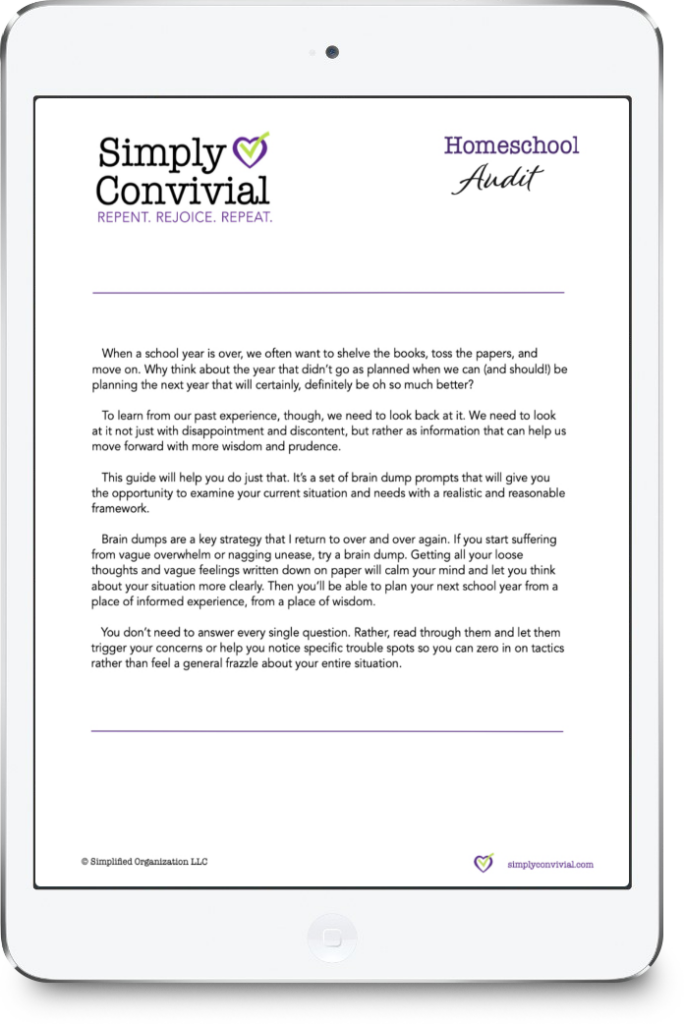
HOMESCHOOL AUDIT
Make next year better based on how this year went.
Download the free homeschool audit and use this year’s experience to make next year better.
5-Step Classical Homeschool Preschool Plan
Here is the school year plan for my youngest when she was four. It is very similar to what all her older siblings did, as well.
- Participate in Morning Time, including memorizing one poem per term.
- Memorize Catechism for Young Children Q&A 1-45, practicing one-on-one during couch lessons.
- Practice phonics with TATRAS and alphabet books, possibly moving to BOB books if/when she’s able to blend sounds.
- Learn to write the alphabet and her numbers, starting at the top.
- Have lots of stories and poems read to her, including by siblings & audio books.
If your preschooler has older siblings who could use some reading practice (and probably all of them can! reading aloud is a skill that takes practice!), then assigning the older sibling to read a chapter or picture book to the preschooler or toddler is a great way to cover two bases at once.
I also bought Math-U-See Primer for her, but my plan is that she won’t start that until January. Until then, she’ll practice writing her numbers with Pam Barnhill’s free number sheets and tracing pages I make with StartWrite. She also has tracing pages with the alphabet, her name, and her siblings’ names made with StartWrite (we do the Italic hand).
My last four-year-old practiced writing her numbers with Pam Barnhill’s free number sheets and tracing pages I made with StartWrite. She also has tracing pages with the alphabet, her name, and her siblings’ names made with StartWrite (we do the Italic hand).
How to Homeschool Kindergarten
I fully subscribe to Charlotte Mason’s recommendation for those under 6:
“In this time of extraordinary pressure, educational and social, perhaps a mother’s first duty to her children is to secure for them a quiet growing time, a full six years of passive receptive life, the waking part of it spent for the most part out in the fresh air.”
Now, my 5-year-old didn’t learn to read while living a passive receptive life out-of-doors, of course. He learned to read because he wanted to be part of his older sister’s phonics lessons and he picked it up quickly and intuitively.
My rule of thumb for lessons for all children 6-and-under (yes, even including 6-year-olds) is that they don’t have to do any school lessons they don’t want to. When my oldest was 6 & 7, this was primarily a survival strategy as I had my hands full with all-littles and moving.
I worried that we’d have a hard transition when he was required to complete things. I was worried he’d not learn a work ethic if I didn’t make him buckle down and do lessons he didn’t want to do. But, he was reading and so I figured we were fine with whatever for awhile.
And I was right. And I’d have been right even if he wasn’t reading.
All learning is a self-directed process. Not that they don’t need guidance and lessons, but you can’t force learning onto or into someone. Learning is work they have to do for themselves. If they aren’t receptive to it, you’re wasting your time.
Of course children eventually must learn to do the work of learning whether they feel like it or not, but I don’t think they’re even able to do that developmentally or emotionally until 8ish or so – whenever they start arguing about the work instead of thinking it’s so neat to have a math worksheet.
Just like you’re only making fruitless work for yourself if you try potty-training a child who isn’t interested or try teaching a baby to walk who is content to crawl or roll, I think it’s perfectly safe and natural to let learning happen as they are open and receptive and interested for those six-and-under.

How much time should kindergarten take?
My rule of thumb for starting young kids out with school work has been that they don’t have to do school until they’re 7. Before that, they do school when they want to. If they don’t want to, they can look at books, play outside, play with toys, draw – whatever wholesome activity they do want to do.
But lesson time in our homeschool is never mandatory before 7 with the exception of joining the family for Morning Time.
If they are going to do school, they do have to do it well – and if they aren’t in the mood, I’m not going to force the issue.
Often, they do want to do their minimal school – especially those with older siblings. They want to be big, and school is what big kids do.
An eager learner is receptive while a resistant learner is not.
It’s almost palpable: she’s trying, starting to succeed, and is on the verge of the big “click” for reading. One of my children had a long phonics runway and more of a gradual dawning than a big click, but the signs are pointing to this particular student being a “click” moment reader.
In other words, not forcing lessons when they’re young has not created bad habits, but it has helped us avoid learning the habit of fighting over lessons before real lessons have even begun (they learn it well enough when they’re 9 and again when they’re 11 anyway).
Instead, it helps us keep up the atmosphere of learning being a fun privilege – one you can’t have if you’re grumpy or stubborn. Fussy kids get naps, not reading lessons.

HOMESCHOOL AUDIT
Make next year better based on how this year went.
Download the free homeschool audit and use this year’s experience to make next year better.
Phonics Curriculum
For phonics I use TATRAS, which is now out of print. If you ever see a copy out in the wild, snag it!
Similar options available now would be Brandy Vencel’s Teaching Reading with BOB Books or All About Reading. What I like about TATRAS, Teaching Reading with Bob, and All About Reading is how they teach phonograms rather than teaching kids that English is a bunch of “exceptions.”
Phonics is actually straightforward. English has very few exceptions if you learn phonics thoroughly. If the program you’re using teaches otherwise, get a better program.
To work on fluency with budding readers, I love the Bob Books, Pathway Readers, and everything Cynthia Rylant & Arnold Lobel.
We’ll spend just 5 minutes going over our phonogram chart and a word list, then practice reading with a page or two from a reader.
Literacy in Kindergarten
For read-alouds the kids get to pick one what they want from our picture book basket (which I have purged so that it only contains books I love). I like lots of fairy tales, folk tales, and classic stories, plus the great characters like Frog and Toad and Frances.
For handwriting I use Penny Gardner’s Italics: Beautiful Handwriting for Children. I bought the pdf in 2008 and am still printing pages off in 2024.
During our typical kindergarten or first grade year, my 6-year-old has spent nearly an hour hearing and repeating Truth couched in beautiful language, done some busywork math, practiced reading and writing for 5 minutes each, and listened to good stories.
Pretty solid first grade right there. The best next priority, I think, is simply to furnish the 5 or 6 year old with plenty of self-directed, open-ended play, preferably out-of-doors.
What to do after they can read
One thing I know now after having 4 fluent readers is that the reading practice she needs comes best from multiple sources and is done in multiple modes. We don’t need one reading session together and that’ll do it. Here’s how I’ve built in reading practice for her:
- Read a memory passage aloud straight from the Bible in Morning Time
- Following along and reciting catechism answers from the Psalter in Morning Time
- Reading the copywork/handwriting sentence that also counts as spelling
- Reading one book to herself per day (15ish minutes) that she narrates to me afterwards
- Listening to an audio book or read aloud and follow along (following along with the singing in a hymnal counts, too)
- Read aloud from a slightly challenging book with someone (ie me) who will coach her over the hard words
- Lots of free-choice easy reading
So obviously some of these things are happening in other areas of our day: Morning Time includes reading practice, handwriting includes reading, bedtime is the perfect time for easy reading.
For the other reading, she’ll listen and follow along with the Bible Reading Challenge on the YouBible app which makes following along super simple (and is easy-tap for doing the next day’s reading).
For her reading and narrating, she’ll read a chapter in The New Children’s Bible then come tell me about it. I had started her out on Wondrous Works of God by Starr Meade, but switched it out because her narrations were not good. She could read the words, but the story was told with a level of interpretation and connection and abstraction that she’s not ready for yet. She needed a simple story version.
For her read-aloud with me time, we’ll work through reading through the My Book House series.

Notice that everything I assign (ie not the free easy reading) includes content that in itself is also worthwhile. That’s what it is to give a classical education at this phase. That and that alone, pretty much.
Then, this year, I’ll simply watch and direct if needed. When she’s board, will she pick up a book? When she’s waiting, will she pick up a book? When she ought to be doing her chores, does she pick up a book instead? If so, she’s becoming a reader. If not, I’ll strew and I’ll hint and I’ll woo toward choosing books.
Related: Raising Readers
Kindergarten Math Curriculum
Before the kids are ready to begin Kindergarten or first grade math, we use number and counting pages only if the child wants to do math. There’s no actual progress or importance to doing number worksheets. Your 3, 4, and 5 year old will not be ready sooner or know more because she did number activities or worksheets. She will know more if you fold her into your daily life and talk to her all day long as you work. She will know more if she has hours out of doors and hours of being read and sung to (by you or audio books and Spotify).
That said, Pam Barnhill’s free number pages are my favorite for when the little ones insist on having their own math.
At 5, if the child has the fine motor skills and attention to begin, we start with Math-U-See Primer, moving at each student’s pace. No rush.
History & Science in Kindergarten
My history plan for preschool, Kindergarten, and first grade:
Don’t do it. Wait. Read good books. Play outside.
My science plan for preschool, Kindergarten, and first grade:
- Play outside.
- Watch grownups do things.
- Lots of free creative and non-screen play time.
Yes, that really does add up to better science studies and knowledge in the later years. Older homeschool moms told me it was so, now I am an older homeschool mom who knows it is so, and also the book on classical education titled Teaching Science So That Students Learn Science says so.
Kindergarten Bible Curriculum
One read-aloud in our stack will always be from a Story Bible, plus a bit from Leading Little Ones to God by Marion Schoolland for 5- and 6-year-olds.
Plus, through Morning Time we sing, pray, and memorize Scripture & catechism.
Will my child want to learn?
When my first and second kids were kindergarten age, I was worried that only doing lessons when they wanted was letting them be in charge. I was afraid it’d be a bad precedent, a bad habit that we’d then have to break.
Trying to push at this stage is more likely to cause issues that will need to be reworked and untangled later. It will not cause them to be advanced students any more than working with them to walk will make their walk earlier or be better walkers than later developers.
But a new school year, after even a short summer break, allows for new rules to be set for a fresh school year with its own excitement. Setting new expectations helps the children see that they are getting bigger and growing up. They respond well to it.

HOMESCHOOL AUDIT
Make next year better based on how this year went.
Download the free homeschool audit and use this year’s experience to make next year better.
The goal of kindergarten
Written after completing our first first-grade year in 2010.
If it is true that all real education is self-education, then this almost-complete year of “First Grade” has not been such a loss as the partial and skipped and missed check boxes on the lesson plans might lead one to believe.
“Therefore, teaching, talk and tale, however lucid or fascinating, effect nothing until self-activity be set up; that is, self-education is the only possible education; the rest is mere veneer laid on the surface of a child’s nature.”
Charlotte Mason
We may not have gotten done all I had planned to get done, but the honest truth of it is that I never expected to get done all I planned, especially after learning I was pregnant and we would be moving.
My primary goal for this year’s studies was to practice a school routine and lay foundational skills: reading, drawing, narrating, knowing a bit about the physical world and maps (geography), knowing the main story-line and people of the Old Testament, and being able to follow directions. As far as those goals go, our year has been respectable.
One thing I found was that the solid first term last summer succeeded at what I thought was too lofty a goal to even hope for: sparking interest that would lead to self-initiated learning.
Interest in Drawing

In the first and second term of the year we had drawing instruction. I used Drawing with Children and taught the boys the basic elements of shape and had them do copying exercises.
We also used Draw Write Now for drawing practice. The boys have always liked drawing, and they would spend hours drawing. Hans even began copying pictures from non-drawing books. And, by the third term, they were drawing so often and were increasing in skill by their own desire and effort, that I left off doing drawing during school time.
As a form of narration, I began having Hans draw or copy a picture from a geography-related book he read. Both boys now draw quite well and love drawing.
Interest in Nature Study
Really, our nature study has been a pathetic handful of 15-20 minute sessions observing something outside and trying to describe it with words and then observing it while attempting to draw it. However, what Hans has picked up is that “studying” something means observing it carefully.
Now he’ll run in occasionally from playing outside and exclaim, “Mom! Can I have my clipboard and pencil? I found a really interesting rock and I want to study it!” The first time he did this I was rather dumbfounded.
Related: Nature Study As Independent Work
The truly educated person has only had many doors opened. He knows that life will not be long enough to follow everything through fully.
Susan Schaeffer MacAulay
Interest in Geography
Geography has been our only knowledge-subject (except Bible) for the year, and looking at the books and the plans I made, I tend to be disappointed at what I actually accomplished.
However, Hans and Jaeger have both discovered that the world is big and interesting and full of very different sorts of places and people. And I have found that interest, which I thought would be hard work to kindle, is more naturally occurring than I supposed; and I have found interest kindled even in myself for things I had previously thought were dull or simply “not my thing.”
But, not only do they have a sparked interest in the world, but between Geography Songs (which I can at least just turn on and have them listening even when we haven’t “done” school) and the GeoPuzzles my parents bought them for Christmas, they know a lot of country names and places and thoroughly know the continents and oceans.
What they have remembered most to distinguish the different continents is what kind of animals live in each, which wasn’t even part of my plan to teach.
They learned it because of their own interest and because I brought home stacks of library books each term that they at least looked through or read on their own even if I didn’t read them aloud to them.
Education is not filling a bucket, but lighting a fire.
William Butler Yeats
Interest in Reading
Hans reads on average 2 hours a day, at a rate of something like 60 pages an hour at least. Encyclopedia Brown is a book-a-day series for him, and it takes him 2-3 days to read a Little House book or others of that size. Thankfully he has no prejudice against rereading books.
I have done my best to keep him in books and to vary the type of book he reads. I read a lot when I was little but always stuck to one particular genre. I disdained animal books, didn’t care about adventure books (and any book that my brother said was good), and pretty much just read all the fluff romantic historical fiction I could get my hands on — which was a lot and still plenty to keep me in books. :) So far, so good in keeping Hans’ reading eclectic.
When we didn’t do our lessons while I was in late-pregnancy, some days Hans spent up to 5 hours a day reading — of his own accord — and so I didn’t feel so bad about missing “school.” And now Hans is becoming more and more of an interesting person to talk to, because I don’t know what he knows and he learns a lot even from the fiction he reads.
I know he thinks about what he reads because in the middle of doing a chore or drawing a picture, he’ll suddenly ask how to say a particular word or ask what a particular word he read means.
He has even appropriated jokes from a story and applied them with effect in conversation. Literacy in action.
“A love of reading is an acquired taste, not an instinctive preference. The habit of reading is formed in childhood; and a child’s taste in reading is formed in the right direction or in the wrong one while he is under the influence of his parents; and they are directly responsible for the shaping and cultivating of that taste.”
H. Clay Trumbull
Wanting Books for Knowledge
Both boys love pouring over DK Eyewitness books, atlases, art books, and any other picture-heavy information book. Over the course of the year, through his reading, through the geography books I’ve brought home from the library, through conversations with his dad (such as about WWII fighter planes) and other people, Hans has discovered that there is a vast amount of fascinating things in the world and that the library has books about them. That alone makes this year a success in my mind.
When he asked the other day if we could go to the library because he wanted some books about World War II, a couple days after Matt had told him a few things about biplanes, I felt like my mission really had been accomplished.
“We prefer that they [the children] should never say they have learned botany or conchology, geology or astronomy. The question is not, – how much does the youth know when he has finished his education – but how much does he care and about how many orders of things does he care?”
Charlotte Mason
So, my self-evaluation of this school year that is nearing its finish finds my own efforts have been lacking and half-hearted, but that God is gracious and that what my children learn doesn’t depend solely on my own efforts. Praise God.
Add Indoor PE to Preschool
Have I already told you that this trampoline is a winter-time, four-year-old-boy lifesaver? It’s still true. It qualifies as our best purchase this season, for sure.
Knox’s checklist (which he insisted upon having) says, “Jump on trampoline, counting to twenty.” It’s great. And, since his counting isn’t totally linear, sometimes he jumps longer than twenty and sometimes I can say, “Oh, you missed several numbers. Go try again.”
Best Picture Books to Read Aloud
There are lots of great picture books out there, but these are the ones I absolutely love, the ones I have no problem reading every day. These are the top 12 picture books that I would go so far as to replace with beautiful hardbacks for my own house when I am a grandmother.
I was going to do top 10, but by the time I deleted to 12, I couldn’t bear to pare back further. There are many more picture books I love, but these are the ones I will replace even after I no longer have young children.
- St. George and the Dragon
- Chanticleer and the Fox
- The complete Frog and Toad
- All the Frances books, but especially Bedtime for Frances
- The Story of Ping
- The Little House by Virginia Burton
- Miss Rumphius by Barbara Cooney
- Fritz and the Beautiful Horses by Jan Brett
- Always Room for One More
- A House is a House for Me
- The Owl & the Pussycat illustrated by Jan Brett
- The complete treasury of Beatrix Potter
I collect fairy tale picture books, favoring those with gorgeous illustrations and original endings, even if they’re gruesome. I want stories and pictures that convey that elusive sense of faerie.
Sadly, most of these I acquired from our library book sales over the years – these were books they were getting rid of to make way for graphic novels and vampire stories. Sigh.
Individual Stories
- St. George and the Dragon by Margaret Hodges, illustrated by Trina Schart Hyman
- Rapunzel by Barbara Rogasky, illustrated by Trina Schart Hyman
- The Donkey Prince by Jean Craig, illustrated by Barbara Cooney
- Shoemaker Martin by Barnadette Watts
- Comus by Margaret Hodges, illustrated by Trina Schart Hyman
- The Three Little Pigs by Paul Galdone
- Three Billy Goats Gruff by Paul Galdone
- Twelve Dancing Princesses by Marianna Mayer
- Twelve Dancing Princesses by Ruth Sanderson
- The Ugly Duckling by Jerry Pinkney
- Cinderella by Marcia Brown
- Cinderella by Ruth Sanderson
- Chanticleer and the Fox by Barbara Cooney
- Bearskin by Howard Pyle, illustrated by Trina Schart Hyman
- Merlin and the Making of the King by Margaret Hodges, illustrated by Trina Schart Hyman
- Beauty and the Beast by Marianna Mayer
- Rumpelstiltskin Paul O. Zelinsky
Collections
- Candlewick Book of Fairy Tales by Sarah Hayes
- Tasha Tudor’s Book of Fairy Tales by Tasha Tudor
- Tasha Tudor’s Bedtime Book by Tasha Tudor
- The Old-Fashioned Children’s Storybook
- Hans Christian Andersen’s Fairy Tales by Lisbeth Zwerger – my favorite (her stories also come as individual books)
Audio Books Count as Reading Aloud
That’s my position and I’m sticking to it. Reading aloud is essential for kindergarten and first grade students, so the more ways you can add it to your homeschool lesson plans, the better. Audio books make more possible.
These are the books I’d purchase again in a heartbeat, even paying full price for, if I had to. Using audio books helps save my voice and my sanity, giving the kids the culture and experience of shared books without my having to stay on the couch for hours on end, being the reader.
I’m not good at reading aloud. I’ve improved greatly over the years, but I still rely on audiobooks and MP3 players more than my own dedication to reading aloud myself.
Picking 10 was hard enough; as it is, these are not in any particular order.
- Winnie the Pooh. I once tried to read this one aloud and it made no sense. Read by Peter Dennis, however, it is winsome and engaging and now the source of many family quotes.
- Little House. This series can only be made better by being accompanied with fiddle music, which this version is. It’s a childhood classic not to be missed.
- Narnia. Narnia should be visited multiple times over a childhood, and the audio series makes that journey so much simpler to begin again.
- Blue Fairy Book. This is another book I have a hard time reading aloud, but my 6-year-old daughter will listen to story after story during her quiet time.
- Wind in the Willows. If you’ve never rollicked with Mole, Rat, Toad, and Badger, you’re missing out.
- Story of the World. All 4 volumes, kept in the car and played multiple times over the course of a few years is an adequate young elementary history study in my book.
- Heidi. I like to leave the German names to a professional. When left unabridged, Heidi is a Christian tale of love and redemption.
- The Hobbit. Books with songs and poems also are better on audio than read by me.
- Old Yeller. I didn’t think I liked this book until I heard it read aloud to me by Jim Weiss. That version appears to be out of print, but it’s what our library has.
- Little Princess or Secret Garden; I couldn’t make the call between them, so you’ll just have to do that for yourself.

HOMESCHOOL AUDIT
Make next year better based on how this year went.
Download the free homeschool audit and use this year’s experience to make next year better.






